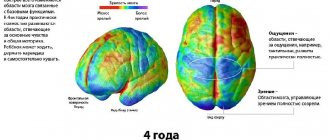Greetings, friends!
As soon as it is born, a newborn child begins to learn to interact with the world around him. At first he does not understand what is happening around him and only instinctively identifies the image of his mother. But as he grows up, he begins to recognize other people, tries to imitate them and repeat their words - this is how he learns to be human. Thanks to this imitation, his consciousness and psyche are formed. This process is called interiorization, and today we will talk about what it is, what it is like and how it affects our lives.
What is interiorization
Interiorization is the process of forming a person’s mental structures through the acquisition of life experience. Translated from Latin, this word means a transition from external to internal, that is, in the process of interiorization, external activity gradually turns into mental operations.
In psychology
Internalization in psychology is briefly defined as the process of formation of mental processes through the assimilation of external activities that are accepted in society.
In pedagogy
In pedagogy, interiorization, in simple words, is the process of developing a child’s ability to handle symbols. That is, at first the child performs external activities, and over time it “collapses” and becomes more and more symbolic. In the theory of education, they most often talk about the stages of internalization of value orientations.
History of the development of the concept
The author of the term is considered to be the French sociologist Emile Durkheim (1858-1917). At the same time, his understanding of what interiorization is was very different from the modern one. He considered it one of the key elements of socialization , a connecting link between the internal and external world of the human psyche. Many of his colleagues also considered interiorization a purely sociological concept.
Later, Pierre Janet (1859-1947), Jean Piaget (1896-1980) and other representatives of the French school of psychology began to consider it as a psychological concept. They used the term “interiorization” to refer to the transfer of social thinking characteristic of an individual’s social group into his inner psyche.
This concept was brought to its modern form by the Soviet scientist Lev Vygotsky (1896-1934). In his opinion, interiorization is the most important factor in the formation of the human psyche and thinking. Later, his research was continued and significantly supplemented by Pyotr Halperin (1902-1988).
Stages of interiorization
At the first stage, the adult influences the child with words, encouraging him to act. For example, he tells him: “Come on, let’s build a pyramid.”
On the second, the baby masters the way of addressing himself, tries to influence himself with the help of words and performs the action. He can turn to himself: “Misha, let’s build a pyramid?”, and after that he begins the activity.
At the third stage, the child already confidently influences himself with words, and does this in his mind, and not out loud.
The sequence of stages of internalization of value guidelines is exactly the same: first, the adult reports the correctness of this or that action, then the child pronounces it out loud, and, ultimately, assimilates it at the mental level.
Interiorization and communication
Communication plays a special role in internalization. It is this that shapes consciousness, absorbing the authorities and values accepted in society.
At the first stage of life, the main and main authority for a child is his parents. The baby perceives the words and actions of loved ones as an indisputable truth and tries to imitate as much as possible the rules of behavior accepted in the family.
Growing up, a child expands his social circle, forcing his consciousness to contrast the priorities of society and family values, and then, focusing on his inner conviction, choose his own path. In most cases, mature children prefer to remain in their familiar environment, having absorbed the way of thinking, rules of behavior and authorities represented by their parents.
Tactile contact is no less important for interiorization.
Research has shown that children left without parental care and forced to live in a medical institution until the age of 3, where communication standards were limited only to the necessary medical framework, although they understood their native speech, and also had a small set of words, they preferred to communicate in their own language. own language, and also had problems with hygiene skills.
Most orphans did not know how to brush their teeth, use a spoon or dress themselves. During communication with teachers and children living in the orphanage, the psychological state of the children gradually leveled out.
Mechanism of interiorization
The mechanism of internalization or transformation of actions, according to P.Ya. Halperin, includes 6 stages.
At the first stage, a motivational component is included, best if it is a manifestation of natural cognitive interest. But there may also be an adult’s call for activity, for example: “Today we will learn to fold objects.”
At the second stage - the indicative component. The child watches as an adult adds one to two cubes and gets three.
The third stage is material. The child takes objects and puts them together himself.
The fourth is the stage of external speech. The child, already without objects, can say: “If you add three to two, you get five.”
The fifth is the stage of inner speech. The kid says the whole phrase to himself: “If you add three to one, you get four.”
The sixth is the stage of mental action. Speech is curtailed and mental action is performed at a very high speed, that is, the child learns to count in his head.
Interiorization and experience
Of great importance in the transformation of personality and the process of internalization is experience, which helps to choose a system of values, determine the worldview and image of a person’s relationship with the world around him.
It is impossible to pass on the experience of past generations to a child. It is possible to teach a child mastery, accumulated knowledge or skills with the secrets, but each person gains experience independently.
Going through difficult life situations, each person draws his own conclusions, which does not make it possible to assimilate the knowledge of the previous generation and avoid new mistakes. Experience previously acquired by parents or other members of society can help predict the development of the situation, but does not make it possible to avoid it.
Psychologists note that overcoming difficult life obstacles helps to strengthen and strengthen a person’s internal qualities, since by transforming previously gained experience in the process of interiorization, a person gains not only knowledge, but also improves his psychological state.
Areas of application
Interiorization is most often used in the educational process, when a teacher needs to teach a child to perform various mental actions. It is also used in the process of education: the child develops mental actions regarding correct behavior in society.
In adult life, internalization can also be used in relationships between superior and subordinate or between mentor and trainee.
Notes
- ↑Interiorization // Dictionary.ru
- ↑Yasnitsky, A. (2018). Vygotsky's science of Superman: from Utopia to concrete psychology. In Yasnitsky, A. (Ed.). (2018). Questioning Vygotsky's Legacy: Scientific Psychology or Heroic Cult. London & New York: Routledge.
- ↑'Vygotsky' on Google Scholar
- ↑Cit. by: May R.
Discovery of Genesis. - M.: Institute of General Humanitarian Research, 2004. - P. 91. - ↑ Kovalev G. A., Radzikhovsky L. A.
Communication and the problem of internalization // Questions of psychology: journal. - 1985. - No. 1. - P. 110-120.
This page was last edited on April 3, 2021 at 11:15 am. Sources used:
- https://strelkamag.com/ru/article/vocabulary-intriorisation
- https://wiki2.org/ru/interiorization
An example of interiorization in psychology
The process of internalization in psychology can be clearly seen in the example of a child who assembles a sorter. First, the adult shows him and says: “A round figurine goes into a round hole, an asterisk goes into an asterisk.” Then the baby says the same thing out loud to himself and performs the action. At the next stage, he pronounces the necessary actions only mentally. At the last stage, he quickly matches the figures with the holes and successfully performs the actions at high speed, without thinking, and without errors.
Study methods
The study of internalization is carried out through:
- a conversation that allows you to assess the internal integrity of the individual and the ability to transfer observations and actions received in the outside world and society into your inner world;
- monitoring the process of internalization of the child;
- experiments conducted in a natural environment, and allowing us to find out how quickly a person’s consciousness allows him to assimilate new experience;
- testing.
Classification
Interiorization is similar to adaptation. It has 3 types, each of which belongs to a specific age:
- Initial. Typical for newborns. The child begins to explore the outside world and interacts with it through games with his mother or father. Adults show the child toys how to use them correctly. The baby looks at their actions, remembers them, and then repeats them.
- School adaptation. Learning depends on the thought process. At this stage, the internalization of the personality depends on motivation, type of temperament, and characteristics of the development of the nervous system.
- Social adaptation. This type of internalization begins at birth and continues throughout life.
The last type of adaptation is divided into three circles, depending on the proximity of communication with other people:
- the first is close relatives;
- middle - neighbors, friends, distant relatives;
- distant - acquaintances, colleagues.
Debriefing script
Each conversation should have a script; it will be an additional support for a psychologist who also has to work in extreme conditions.
Debriefing is often carried out in the form of a training session, when participants sit in a circle, but in this case they prefer not to leave empty space in the center, because this unusual environment can be perceived by the participants as a threat. To make the conditions as comfortable as possible, use a round table.
Debriefing consists of three main parts:
1. Reproduction of what happened.
2. Analysis of symptoms and reactions.
3. Mobilization of the psychological state of health.
In addition, the entire process is divided into phases:
- Acquaintance. As in a regular training, participants must give a name and tell some information about themselves.
- Statement of facts. At this stage, the victims tell what exactly they had to endure. How they realized that trouble was approaching, their further actions.
- Impression phase. Participants share their experiences, thoughts, emotions. If the conversation reaches a dead end, the coach must warm it up with questions: “What did you think about what happened?”, “How did you assess the situation around you?”
- Feeling phase. The longest and most important stage. Many victims experience emotions that were previously unfamiliar to them, which makes them seem wild, strange, and shameful. Everyone believes that such a revolution of consciousness is happening only to him, but during the conversation he understands that everyone is experiencing similar feelings. Mutual support and emotional connection are born. This key point in the debriefing depends primarily on the trainer, who must encourage participants to be sincere.
- Symptom phase. It doesn’t have to be singled out as separate; it is often included in the previous one.
- The presenter and his assistants (also psychologists) must process information about the feelings of the participants, give instructions for the future, and talk about possible psychological manifestations.
- Training to smooth out negative psychological manifestations in the future. At this stage it is possible to arrange another meeting.
Social adaptation
Social internalization also begins from birth. Here the following levels of relationship between the individual and society are distinguished:
- close circle of friends (parents, brothers, sisters and other relatives);
- middle circle (neighbors, kindergarten, school, friends, etc.);
- distant circle (small homeland and country of birth as a whole).
In communicating with relatives, the child adopts, i.e. internalizes, family values - this is the type of relationship between parents, intrafamily interests, patterns of behavior with others, religious preferences and attitude towards the world as a whole.
Going beyond the family, the child observes the patterns of relationships adopted by people with whom he often comes into contact, and can adopt their ways of acting.
Birth in a certain country also leaves a special imprint on a person’s self-determination: cultural and religious traditions, language of communication, national cuisine, moral values and individuals whom society has chosen as its heroes. For example, in Soviet society of the 30-40s of the last century, the heroes were pilots, Stakhanovites, party leaders, and the younger generation wanted to be like them. Then the heroes were cosmonauts, “new Russians”, oligarchs, etc. Success in society will depend on the level of a person’s compliance with external ideals currently accepted in society.
Personality formation according to P. Ya. Galperin
Work in this direction was continued by the Soviet scientist P. Ya. Galperin. His merit lies in the fact that he continued the line of study of this phenomenon set by L. S. Vygotsky, which differed from the opinion of foreign scientists. J. Piaget assigned interiorization a secondary importance in the formation of the psyche up to a certain age; logical thinking was in the foreground. The transition from non-mental to mental (i.e., as a material action) becomes an internal process and is not illuminated.
On the contrary, L. S. Vygotsky and then P. Ya. Galperin insist that internalization is the key mechanism for transferring external impressions to the internal plane at all stages of development. The issue of the transition of the non-psychic plane to the mental plane is studied in depth.










